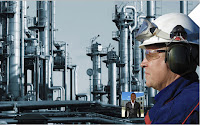Production Stage
The production stage
is the most important stage of a well's life, when the oil and gas are
produced. By this time, the oil rigs and work over rigs used to drill and
complete the well have moved off the wellbore, and the top is usually outfitted
with a collection of valves called a Christmas tree or Production trees.

These
valves regulate pressures, control flows, and allow access to the wellbore in
case further completion work is needed. From the outlet valve of the production
tree, the flow can be connected to a distribution network of pipelines and
tanks to supply the product to refineries, natural gas compressor stations, or
oil export terminals.
As long as the
pressure in the reservoir remains high enough, the production tree is all that
is required to produce the well. If the pressure depletes and it is considered
economically viable, an artificial lift method mentioned in the completions
section can be employed....
Read More.





